#steel anchors for construction
Explore tagged Tumblr posts
Text
Understanding the Importance of House Foundation Specialists in Seattle
#Garage Foundation Problems Seattle WA#Gaps and Spaces Seattle WA#Sloping & Uneven Floors Seattle WA#Sinkholes & Voids Seattle WA#Chimney Problems Seattle WA#Foundation Settlement and Sinking Seattle WA#Stair & Stoop Repair Seattle WA#Repair Solutions Seattle WA#Helical Tieback Anchors Seattle WA#New Construction Piers Seattle WA#Concrete Leveling Seattle WA#Polyfoam Concrete Lifting Level Slab-Jacking Seattle WA#Helical Piers & Anchors Seattle WA#Industrial Foundation Repair Seattle WA#Wall Plate Anchors Seattle WA#Commercial Foundation Repair Seattle WA#Residential Foundation Repair Seattle WA#Soil Nailing Seattle WA#Hydralic Slab Lift Piers Seattle WA#Steel Piers Seattle WA
0 notes
Text
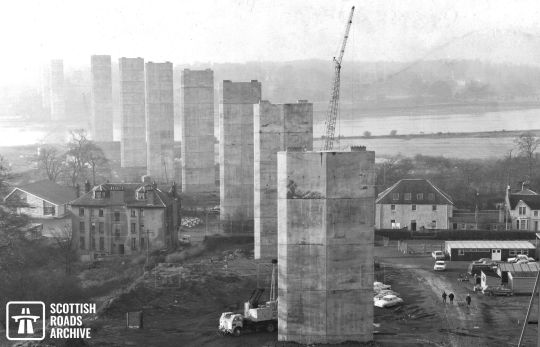


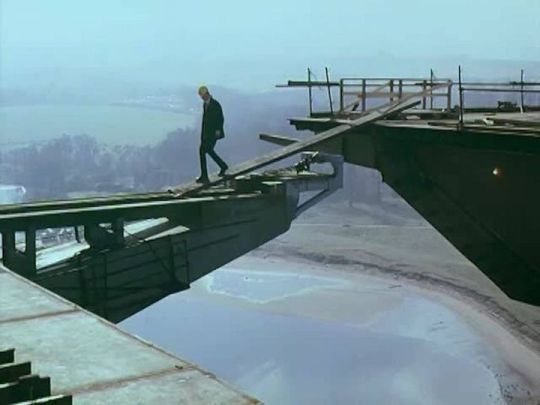
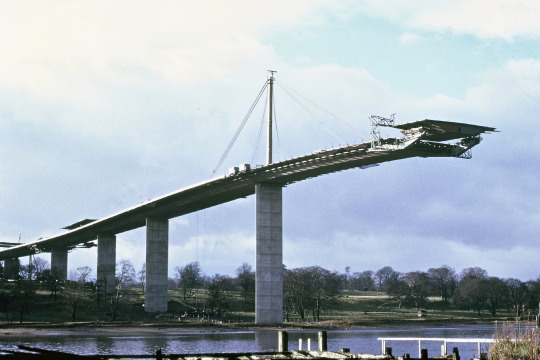






On July 2nd 1971 The Erskine bridge was officially opened.
Construction on the project began in April 1967 at a cost of £10.5m, which is the equivalent of almost £150m today.
The bridge was designed by Freeman Fox & Partners for the Erskine Bridge Joint Committee. Dr Oleg Kerensky was the partner in charge and the chief design engineer was Dr William Brown under the supervision of Sir Gilbert Roberts. The piers and foundations were designed by W. A. Fairhurst & Partners. The consultant architect was R. E. Slater.
The central span is 305m (1000ft) flanked by anchor spans of 110m each. The total length including approach spans is 1322m. The aerofoil box-girder deck is supported by fourteen diamond-plan, single-shaft concrete piers at a maximum height of 45m above the river. Two central pylons extend 38m above the level of the deck. A 6x4 cluster of galvanized steel cables passes over the saddle of each pylon in a centralised, single plane.
The dual carriageway has cycle lanes and footpaths with metal safety barriers, renewed in 2012. The underside of the deck carries four water mains pipes and two gas pipes. In 2017 the cables were painted and aluminium lighting columns were installed.
The Bridge was a state-of-the-art infrastructure landmark in Scotland for its time and remains one of the country's most architecturally and technically distinguished bridges of the post-war period and beyond its date of construction. It is the first example of a large-scale cable-stayed bridge in Scotland and is recognised for its structural simplicity, economy of materials and slender appearance.
It was designed and built during a period of substantial development in civil engineering and road infrastructure. It illustrates the aspirations for economic and social progress in Scottish society and is directly associated with the period of ambitious transformation of Scotland's modern infrastructure during the 1960s.
The Erskine Bridge is one of only three road bridges in Scotland with a main span exceeding 300 metres. Its minimalistic single-cable design remains exceptionally rare for large-scale road bridges. On completion, the Erskine Bridge is understood to have had the longest span of this type in the world. The appearance of many bridges on this scale have been altered by later alteration and engineering works. The largely unchanged appearance of the Erskine Bridge contributes to its special interest.
Some of these pics I unearthed are brilliant, my faves are, probably the first person to cross the bridge, no health and safety back then, and the photo with the PS Waverley passing by during construction.
20 notes
·
View notes
Text
Vincent's New Kid Just Dropped CH 11: Present Day With Short Deepground Flashback
NOTE: It's not a time skip in the Deepground section, it's just to frame Nero's physical trauma more. All that story is still going to be told!
Rating: Mature
WARNINGS: torture, captivity, phantom pain, PTSD
NOW WITH @siringadev's beautiful father-son art!
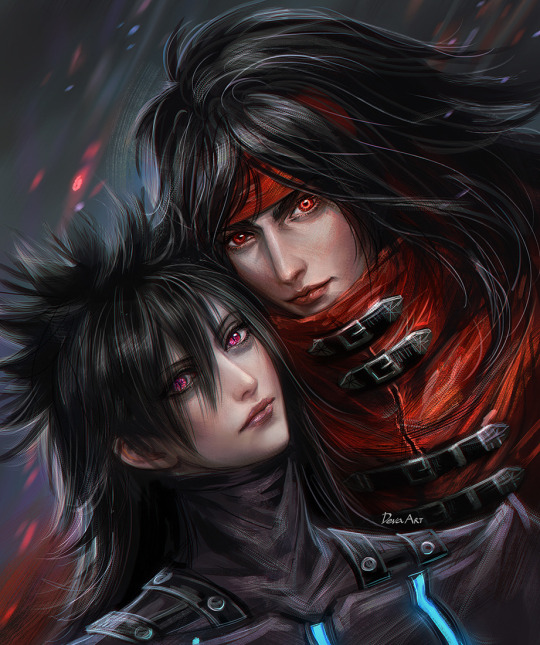
⚰️🕷️
father and son trying to out-edgelord each other but who is winning
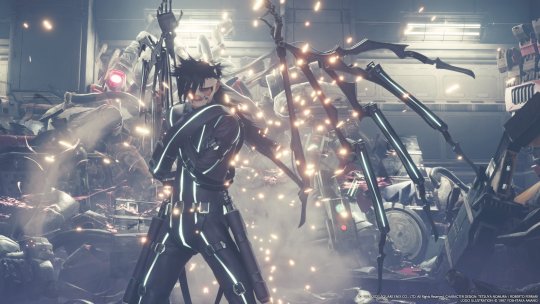
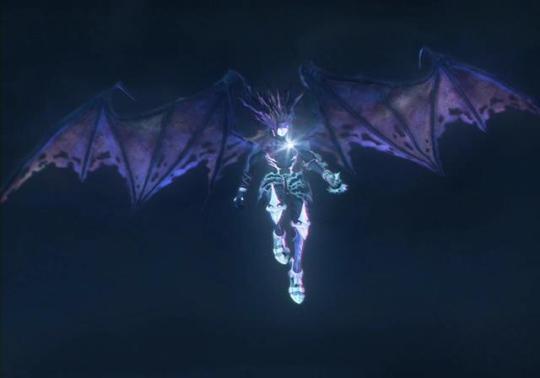
it's vincent
After the Restrictor came, and they implanted those chips in everyone, they sedated Nero and carried him to a dark, cavernous place, in the lowest sub-level of Deepground. Industrial power tools whirred and shrieked. He awoke feeling the vibrations in his skull.
Men were locking heavy shackles onto his wings, at six points. The shackles, they attached to the type of chains that are used for boat anchors; made of iron and as thick as a man’s arm. The chains were hung through huge, steel rings, bolted to a massive support pillar, and hooked up to a construction winch, on the other side.
The Restrictor turned the winch and drew the chains tighter and tighter, laughing while the teenaged boy screamed in agony, pulling Nero’s wings higher and spreading them wider apart, till his shoulder blades felt like they were about to be dislocated, and his feet couldn’t properly rest on the ground.
That was the position he was locked in. Splayed against the gigantic support pillar, like a butterfly pinned to a display board. Muzzled and bound in a straitjacket. Chained by his wings, to the literal foundation of Deepground.
The only way to relieve the pain of bearing his weight on his wings, was to push himself up on tip-toe. He could only do that for so long, before his legs began to tremble with fatigue. Try as he might, his strength would eventually fail, and his legs give out. Then his wings would catch his full weight, and he would scream in agony again.
The Restrictor often lingered nearby, watching him go through this process, drinking in the boy’s tormented groans and cries of distress, with lascivious glee. But he also observed the boy growing stronger and stronger…and more dangerous.
Nero curled up, as the lightning bolts of pain racked his body again, mouth hanging open, a clear stream drool running out onto the floor. Where was his muzzle? Where was his straitjacket? He’d had some kind of cotton jersey shirt on his top half, but he had clawed and torn it to shreds, and it now lay in a purple pile on the floor.
He heard a noise behind him, but he didn’t have time to work out what it was, before he felt the darkness react to something, like a dog jumping in excitement, when its master walks in the door. Weiss! It must be Weiss! he thought, deliriously. Tears of joy leaked from the sides of his eyes, even as they were squeezed shut against the pain.
“W—Weiss…” he rasped, as the darkness reached out toward his beloved. His only one.
He was hauled up to a sitting position, and strong arms wrapped around him from behind, like bands of iron, compressing his crossed arms on his chest, in that familiar position. He was pressed tight against a stone-hard body and lifted to his feet, but…something was wrong. The darkness was curling happily around the person, but making no connection. Not Weiss! his mind screamed.
Enraged, Nero gave his lithe torso a sudden twist, like a snake, trying to wrench himself free, but the arms held him fast. “What the fuck!”
“Calm down,” a smooth, deep voice said, right in his ear. “You’ll hurt yourself.”
“Fuck you! Let me go!” he snarled, thrashing harder, still to no observable effect.
Vincent sighed. “Nero, I know you’re in pain. Let me help—”
“I don’t need your help you bastard!” he roared, kicking his legs, trying to throw this human monolith off balance. He may as well have struggled against the planet itself, for all the man moved. Panting and shaking with fatigue, from even that brief effort, he gave up and hung limply in Vincent’s arms. “I h—I hate you. Fucking die.”
“I can’t.”
As Vincent said this, the room exploded into a whirling, crimson blur, and suddenly, they were atop the roof of the house. Nero’s bare feet stood on the sandy grit of the roof tiles, and blowing wind brought the scent of rain, from the rolling, grey storm clouds, that were obscuring the moon.
“What the hell are you doing?” he asked, in real bewilderment.
“I think I can help, with your pain,” a rasping, resonant, entirely demonic voice answered. “But I can’t try it inside the house. My wings are too big.”
Chaos. The demon’s familiar aura sent shivers of elation up Nero’s spine and made him sick to his stomach, at the same time. He felt bloodthirsty, resentful, filled with rage and grief and underneath it all, a deep, hollow ache. A longing as fathomless as the abyss.
“How do you know I’m in pain?”
“Sephiroth explained, after you went upstairs.”
“Can he ever mind his own business?” Nero grumbled, under his breath.
Acting entirely without his input, Nero’s darkness tendrils suddenly burst out of the black markings all over his body and plunged directly into Chaos, connecting them, like it was plugging him into a power source.
Horrified, Nero tried to make them come back, but his knees buckled and his vision went blank, just then, his brain shorted out by the sudden exposure to unfiltered Chaos energy.
When his vision returned, the demon was still holding him, the same way—Nero’s arms restrained in straitjacket position, and his bare back pressed to its midsection—steadying him on his feet, so he didn’t fall off the roof.
He was trying work out what the hell Chaos was playing at, when he felt it. A dizzying rush of relief, pouring in through the wing brackets on his shoulder blades and coursing through his body. Lack of pain so potent, it was ten times more intoxicating than the headiest pleasure.
Involuntarily, Nero’s head dropped back onto Chaos’ chest and he gave a shuddering moan, as he began to unfurl the demon’s huge, membranous wings, slowly and stiffly, spreading them as wide as they could go.
Tears poured unchecked down his ashen face, weeping openly, as he stretched and folded the wings on the demon’s back, savoring every movement, feeling the contorted phantom segments straightening out, the excruciating knots loosening, the throbbing tautness unwinding.
Nero’s body now felt relaxed and comfortable, being held tightly in Chaos’ arms. Actually, he hadn’t felt this good since…well, in a long time. Now that they believed everything was back as it was supposed to be, the formerly tormented nerves were humming with vitality. Suddenly, the urge to use the wings he’d missed so sorely, was so strong he could taste it.
Nero’s own wings had nothing to do with his ability to defy gravity, so it was something of a shock to him, when he gave Chaos’ wings an exploratory flap, and the two rocketed into the air.
He jolted and cried out in alarm, as the ground fell away and the rooftop shrank below them at a dizzying speed. Chaos, however, appeared patently unconcerned, only taking control to give his wings a few beats (to stop them plummeting directly back out of the sky, and to gain some height for safety reasons), then returning control to Nero.
Nero wasn’t afraid of heights in the least, but he didn’t particularly want to smack into the earth like a meteor, so he scrambled to flap the massive wings. With an effort, he got them under good enough control to keep aloft, then gingerly began to try changing direction.
He was uncoordinated, and kept going awkwardly off kilter. They tumbled and veered multiple times, before he actually began to get the hang of it. But by the time half an hour had passed, Nero was able to fly in relatively steady circles, above the Valentine-Highwind property.
All this time, not a single word passed between himself and the ancient demon, whose body he was essentially sharing, at the moment, but at times he could feel its wordless intent, guiding him. Spread. Glide. Tuck. Bank left. More thrust on the right.
It occurred to him, with a series of complicated emotions, that his father was teaching him to fly. Just like a real father teaching his real son to ride a bicycle. Patiently and calmly, ready to catch him, if he fell. He felt something deep inside him, begin to crack.
Nero, being Nero, bridled and balked. Furious with himself, for being so soft and stupid, and letting himself be taken in so easily, he sullenly withdrew his control from the wings and let them fall, till Chaos lazily caught them and swooped back upward, with effortless elegance, as if it were no more difficult than breathing.
That drew Nero right back out of his morose ruminations. He had thought he’d been doing well, but he clearly had no idea what flying even was. Chaos used far fewer wing beats to achieve the same height and speed, and seemed to be exerting ten times less effort. What the hell? How was it that much different to what he’d been doing?
Spinning like a corkscrew, the demon rapidly ascended, higher and higher, till they emerged from the storm cover in the clear, black sky, where the air became thin and icy-cold, and the the moon shone pure and bright over the sea of clouds.
Nero was staring in undisguised awe at the tens of thousands of glittering stars, when Chaos tucked his wings tightly against his body and dropped abruptly into a freefall. Nero’s stomach flipped and he had to choke down a cry. They fell faster and faster, the wind beating furiously at his face, making his eyes tear up, as they plunged back into the grey clouds, plummeting earthward at terminal velocity.
Just above the treeline, Chaos extended his wings partway and used the downward momentum to shoot forward like a bullet, speeding over the blurred tops of the trees.
As if on cue, thunder rolled and lighting crackled, as the heavy clouds burst, at last. The cold water droplets lashed Nero’s face and his bare torso, as they flew at that logic-defying speed, but he was actually rather thrilled by it. He wasn’t bothered by cold, and he’d never felt rain before.
Apparently sensing that the weather didn’t trouble his passenger, Chaos kept going, soaring nonchalantly through blinding sheets of rain, doing spectacular loops and dizzying barrel rolls, throwing off spirals of water as they went.
Nero had to force down the swell of mirth, that bubbled up in his chest, at the idea of this apocalyptic demon playing around in the rain, to amuse itself. Chaos was having fun, and it showed. If he could have admitted it, without gagging to death, so was Nero.
More than two hours evaporated, and soon they were circling back around toward home—er…toward the Valentine-Highwind house. When they got in close, rather than landing, Chaos did that teleportation thing with the whirling crimson, and they were simply standing in Nero’s room.
Nero hadn’t got his sea legs yet, and turned around unsteadily to blink up at Chaos, who was Vincent again, in his slashed up black jeans and crimson henley, with that stupid headband, as usual. He was also perfectly dry, as opposed to Nero, who was soaking wet, from head to toe, black hair pasted to his white forehead, and quickly creating a puddle, on the wood floor.
Conveniently, Sephiroth (because the world had gone thoroughly insane, and the hero of Wutai was now some kind of super-housewife) had left folded bath towels on the dresser, and put the fresh linens on the bed, while they were out.
Before Nero could say anything, Vincent picked up an oversized bath towel and spread it open, holding it up between them, like a privacy screen. Not quite understanding the prudishness of the gesture, Nero peeled off his soaking wet jeans and underwear, then let Vincent wrap the plushy towel around him.
He still had no idea how to process what happened, tonight. No idea what it meant, or how to react. So he just stood there, dazed, while his father carefully rubbed his long hair, with the other towel.
Fatigue settled on him, with the warmth and the weight of the gentle touch. Now that the pain was alleviated, he was exhausted, down to his bones. Without realizing it, his eyes drooped shut, and his head began to tip forward, by degrees, till it was resting against Vincent’s chest.
Darkness tendrils slithered out of the black markings, all over his naked body, and coiled themselves around Vincent’s arms and waist and neck, like affectionate boa constrictors. If they could purr, they would have, fucking embarrassing things.
“Nero.”
“Mm?”
“The next time you’re in pain, don’t wait for it to become unbearable. Come to me, and I’ll help you.”
…
“Mn.”
THE AUTHOR HAS SOMETHING TO SAY:
nero the wet cat: *HISSSS GRRR HISSSSS* cat dad vincent: *pats dry with towel* nero the dry cat: …. *purr*
LINK TO NEXT CHAPTER:
#nero the sable#weiss the immaculate#vincent valentine#cid highwind#sephiroth#valenwind#dad!vincent#Chaos!vincent#ff7 vincent#the vincent family#weiss x nero#weinero#deepground#final fantasy 7#ff7#deepground tsviets#dirge of cerberus#ff7 remake#Chaos ff7#Restrictor ff7
26 notes
·
View notes
Note
HELLO!!! okay so i’ve recently gotten my severus obsession back and i’ve been writing fics nonstop lol, i was wondering if you could give me some constructive criticism on this fic im planning to publish about eileen and severus accidentally on purpose killing tobias and fleeing to greece.
this is the first part of it
P.S trigger warning for some religious imagery and abuse
ONCE UPON A TIME, when the marks on his back were still fresh, Severus had told himself that he was growing wings.
After all, his mother thought he was an angel, even if his father said he had the devil in him. Severus had never done anything to make his father think that, but the man claimed he could see the shadow in the boy’s eyes. And whenever he caught a glimpse of it, he’d take Severus by the arm and lead him out to the private chapel that sat beside their clapboard house.
Severus used to love the little chapel—it had the prettiest picture window, all red and blue and green stained glass, facing east so it caught the morning light. The floor was made of stone—cold beneath Severus's bare feet, even in summer—and there in the center of the room lay a metal cross, driven straight down into the foundation.
Severus remembered thinking it seemed violent, the way the cross broke and split the floor, as if thrown from a horrible height. The first time his father saw the shadow, he had kept one hand on Severus's shoulder as they walked, the other clutching a coiled leather strap.
Severus's mother watched them go, laid in her own pool of blood. “Tobias,” she had whispered shakily, just once, her own body tattered in violet, blues, greens and reds, but Severus's father didn’t look back, didn’t stop until they’d crossed the narrow lawn and the chapel door had fallen shut behind them. Tobias had told Severus to go to the cross and hold on to the horizontal bar, and at first Severus had refused, sobbing, pleading, trying to apologize for whatever he’d done.
But it didn’t help.
His father tied Severus's hands in place, and beat him worse for his defiance.
Severus had been nine years old.
Later that night, his mother had treated the angry lash-marks on his back, and told him that he had to be strong. That Magic tested them, and so did his father. Her sleeves had inched up as she draped cool strips of cloth over her son’s wounded shoulders, and Severus could just see the edges of old scars on the backs of her arms painted over by the newest ones as she told him it would be okay, told him it would get better.
And for a little while, it always did.
Severus would do everything he could to be good, to be worthy. To not let the magic, the darkness, inside him out. He did everything to avoid his angry father’s gaze.
But the calm never lasted.
Sooner or later, his father would glimpse the magic in his son again, see the darkness pooling in those unnatural black eyes of his, and lead Severus back to the chapel. Sometimes the beatings were months apart. Sometimes days.
Sometimes Severus thought he deserved it. Needed it, even. He would step up to the cross, and curl his fingers around the cold metal cross, and pray—not to God, not to Magic, not at first, but to his father.
He prayed that his father would stop seeing whatever he saw, while he carved new feathers into the torn wings of Severus's back. Severus learned not to scream, not to let his magic lash out, but his eyes would still blur with tears, the colors in the stained glass running together until all he saw was light.
He held on to that, as much as to the steel cross beneath his fingers.
Severus would chant the words his mother taught him, to silence his mind and block out the pain.
Nothing is good or bad without first being determined so by the mind.
Pain cannot touch the mind.
Fear is subservient to the mind.
No wall can imprison the mind.
The body is the vessel and the anchor of the mind.
The mind is both one and multiple.
The mind has many rooms.
Memories half-forgotten and secrets long locked away.
In these natural protective barriers lies the power of the Occlumens.
The Occlumens must divide himself from his weaknesses.
The Occlumens must divide himself from unfulfilled desires.
The Occlumens must not permit a thought that could become a weapon to his enemy.
The Occlumens must place his trust in the strength of his mind.
A scarred mind is a protected mind.
Severus could never truly understand how he was broken, but he wanted to be healed.
If it meant that he would never have to endure such pain again.
He wanted to be saved.
And at last, his liberation came in the form of his father's lifeless eyes.
I’m so insanely and horrifyingly sleep-deprived and I’m on the brink of dying from exhaustion (this is a draft so now I’m in a much better state 😭) but AHAHHSHDJEHRJXKWKNRKFKSD I’M SO HAPPY YOU’RE BACK !!!!!!! I MISSED YOU SMMMM I REMEMBER BEING HEARTBROKEN WHEN I REALISED I COULDN’T FIND YOUR ACCOUNT. Welcome back to the Snapedom 🙏🏼🙏🏼🙏🏼🙏🏼🙏🏼
also WOW I literally read this with half-opened eyes and I still got chills all over my body 😭 I knew you were a great writer but DAMN. plus I LOVE fanfics where Tobias is a religious fanatic and considers witchcraft to be a sin, and he takes it out on Severus. It’s scarily realistic and it very much gives me Claude Frollo and Quasimodo/Esmeralda vibes. I love when people include these kind of themes in their stories/fanfics, so props for that! I genuinely don’t think I have any criticism to give you, I legit got chills all over my body as I was reading this. I think it’s a great idea and I enjoy the details you’ve added. I am not bluffing when I say you have EXTREME potential. If you publish any of your fics, I want you to RUSH to my inbox or DMs as soon as humanly possible 🙏🏼🙏🏼
Again, so glad you’re back!! Your writing is spectacular as per usual 🩷🩷🩷
25 notes
·
View notes
Text
Umbrella Pharmaceuticals - Chapter 56
Summary:
Sergei Vladimir becomes commander-in-chief of the UBCS. Spencer discovers that he is suffering from a degenerative disease.
1
The helicopter landed next to the hangar of a ramshackle airfield. He was told that the airfield would be refurbished after the construction of the UBCS headquarters in the heart of Rockfort, a remote and lonely island that belonged to the Falklands archipelago[1].
The helicopter's rotor stopped and a forty-something man with dull features and a nondescript suit greeted him with a thick British accent. This individual, Walter as he insisted on being called, was to serve as the secretary.
Walter had been personally selected by Spencer from among his contacts, he informed him, and assured him that he would be a good fit because of his proficient knowledge of the Russian language and his tolerance for the former Soviet enemy. Despite Spencer's good intentions, however, he detected that the man was discreetly casting sly glances at him. Finally, a sort of diversion.
Walter escorted him to a clearing where the Jeep awaited to take them to the main house. He was informed that the island was owned by the Ashfords until Alexander transferred ownership to Umbrella Pharmaceuticals. The Ashfords did little with it other than erect a vacation mansion and exploit the tiny local population of Hispanic origin as servants and labourers. This local population had remained in a state of anarchy after the family forgot the island's existence following Arthur Ashford's death. But the libertarian utopia was short-lived with the return of the old order at the hands of Umbrella Pharmaceuticals, for the local population had been forcibly conscripted to work in construction and in sustaining the growing column of mercenaries that Umbrella had hired to take care of the kind of business that only bad men would gladly accept. The eternal return of historical materialism manifested in paradise lost.
The Jeep raced along a rain-dampened dirt track. As they approached the mansion, it smelled of freshly poured cement and gunpowder. Walter, in the back row, shifted in his seat a couple of times because of the inability of his small body not to jump when the wheels hit the numerous potholes that riddled the battered path. The commander-in-chief, for his part, anchored himself in the front seat of the vehicle, aided by his colossal stature and corpulence. A damned Russian bear, the driver's joker remarked as they arrived at their destination.
The mansion was located at the top of a gorge. To cross to the other side, where the barracks were located, one had to descend a flight of stairs to cross a steel bridge that allowed one-way traffic for a single vehicle. Walter informed him that a tunnel would be cut into the gorge wall to connect the mansion with the barracks.
The mansion in question had lost none of its lustre as a luxurious stone building. The style of the property comprised an ecliptic combination of the typical English cottage with the Victorian neoclassicism of Buckingham Palace.
“Commander Vladimir.”
A uniformed man greeted him with a raised arm and introduced himself as his bodyguard. Sergei Vladimir returned the greeting and asked Walter to open the house for him. The secretary took a bunch of keys from inside his jacket and unlocked the intricate locks that had kept the place sealed and protected from the intrusions of the outside world.
The hallway was empty. The wood screamed with every footstep. Cobwebs ornamented the high ceiling and termites had devoured the door frames. Dead insects and rat droppings littered the floor.
“The Ashfords never sent anyone to maintain it,” said Walter, “but you have a room upstairs that has already been fitted out and provisionally furnished for you. The kitchen and housekeeping are also in operation, but we have waited until you were present before proceeding with the refurbishment, and according to your instructions.”
“Very well. At ease.”
Walter bowed goodbye and disappeared through the front door. Sergei wandered into the bowels of the former holiday home. In the ground-floor living room he discovered a tattered Scottish flag and yellowed conservative newspapers congratulating the Allied victory in World War II and railing against the Communist threat, while praising the free market and the Pope and complaining about the debauchery of youth. On one of them, a black and white photo of Stalin during the Potsdam conference had been defaced in biros. Imp horns had been drawn on it, and a handwritten notation had been included in the caption: ‘Thou shalt not destroy us’. He definitely understood instantly why he was hired by Oswell Ernest Spencer.
The Ashfords did not interest him. Spencer, on the other hand, fascinated him. He never knew of his existence until an officer friend told him that a British businessman was looking for mercenaries to form a militia against bioterrorism. Sergei signed up without thinking because of the limited job opportunities that awaited a disaffected Red Army man in Russia. He thought the employer would turn him down, but to his surprise, he found Spencer to be a very nice gentleman who was happy to hire anyone, regardless of their background or political ideology.
He met the old man at his Luxembourg mansion and saw in him a man atypically interested in Sergei's military and political past. Spencer was a classical capitalist and nostalgic for the British Empire. However, this did not prevent him from ingratiating himself with Sergei and listening to a brief lecture on Leninism. But what fascinated him most was not the Englishman's good nature, but the fact that they both shared the impression that the world was in a state of upheaval, the climax of which was hard to guess. In this climate of accelerating change and disorder, loyalty to a greater cause was the only transcendent quality to ensure victory. Sergei was loyal to the Soviet Union, which ended up being a lost cause. Umbrella would not be, because Sergei would be loyal not to the company but to Oswell Ernest Spencer.
Spencer needed his loyalty to carry out his plans for the future. He did not tell him what they were, but assured him that he would benefit greatly from them. Sergei took the job for the simple fact of finding out what those supposed benefits would be, for the money and for the privileges Spencer had promised him as part of Umbrella's paramilitary staff. He just had to be loyal to a greater cause. Semper fi as they used to say in America.
2
“Albert Wesker.”
“Alex. I am Mr. Spencer's daughter.”
They shook hands. She didn't mention his last name. Nor did he read that Spencer had a legitimate daughter. Her American accent gave her away.
“Your father has appointed me as security chief at this lab. I start today.”
“Your office is near mine. I'll walk you there.”
She was nervous. He could see it in her brusque gait and gesticulation. Who was that woman. She really wasn't even Spencer's biological daughter. Her posh American appearance contrasted too sharply with Spencer's old-school manner. A bastard daughter? Had Spencer ever even married? In any case, he didn't give a shit about his private life. What he wanted was to use Alex to continue his creeping rapprochement with Umbrella's executive circle.
Spencer had trusted him. Whether it was because of his previous job as chief researcher or not mattered little to him, what was relevant was that he was there and one step away from the corporate core. Of course, his new job as security chief for a clandestine lab would be temporary. It would take some time, but he promised himself he would rise to the top. There was no fallback plan, no second options: he would take over as much of Umbrella Pharmaceuticals as he could and start running on his own.
He abhorred being a subordinate.
3
Oswell received the medical report. He read it with trembling hands. The results had been positive: he was suffering from a congenital degenerative disease. His life expectancy, at best, would be barely more than ten years in 1992. To survive any longer would be miraculous.
He had inherited the disease from his father Abraham, and Alexandra, his bastard daughter, had inherited it from Oswell. If he did not quickly overcome his addiction to tobacco and alcohol, his life expectancy would be reduced by five years. Like all diseases of genetic origin, it could not be cured, and his was a rare disease with only one effective treatment to improve the patient's well-being while dying.
In conclusion, he had only one option left: the Progenitor virus. The virus resurrected the dying and turned them into nightmarish monsters. So what if the virus could be used to reverse ageing and strengthen the body? What if he could use it to defeat death? He needed Alexandra and all the resources at his disposal to undertake the task of continuing to discover Progenitor's limitless potential.
He would not die in bed consumed by his lack of ambition. He had the opportunity to aspire to be so much more, and he would be so much more. With Progenitor, he would be much more than Oswell, the son of Abraham.
He would be like a deity.
Notes:
[1] Canon info from the official Japanese guide for Biohazard CODE: Veronica Dreamcast.
11 notes
·
View notes
Text




New Legacy Arms – Excalibur – The Sword of Power
The new Legacy Arms Excalibur sword is an update on their classic older model that brings better material, construction and steel tempering to create a fine sword that is also more lively in the hand and able to cut with authority. The sharp blade is forged from tough 5160 high carbon steel and is solidly anchored into the hilt with a peen over the pommel. The crossguard and pommel are crafted from plated stainless steel with a brass finish and the wooden grip is securely bound in twisted stainless steel wire. To make the sword more comfortable than its predecessor, the new wire grip was notably reduced in diameter and flattened to create a more comfortable and sure hand hold.
Excalibur is a name that is synonymous with the medieval sword itself being the legendary sword of the tales of King Arthur which have been told and retold in all forms of storytelling and media throughout the ages. This one takes it features from the Excalibur sword featured in the iconic 1981’s “Excalibur” and the high reception and continuing cult popularity of the movie have “set in stone” this sword as the form of Excalibur in the imaginations of many. Dignified, kingly and full of elegance and power, the broad-bladed sword looks fit for the gauntlet-clad fist of a legendary king or the centerpoint of your own Great Hall.
#Kult of Athena#KultOfAthena#New Item Wednesday#Legacy Arms#Excalibur – The Sword of Power#Excalibur#The Sword of Power#sword#swords#weapon#weapons#blade#blades#European Weapons#European Swords#Medieval Swords#Medieval Weapons#Fantasy Swords#Fantasy Weapons#Longswords#King Arthur#Sword in the Stone#5160 High Carbon Steel#BAttle Ready
8 notes
·
View notes
Text
Xena Rose
The sun hung low over the dry plains, casting long shadows over a seemingly endless desert landscape broken only by jagged rocks and towering mountains in the distance. Xena, the warrior princess, moved through it like she was born of dust and steel, her gaze focused, her steps sure. This was no ordinary place; she could feel it, feel the strange pulsing under the earth. She could sense the watchful eyes of unseen forces, the hum of something ancient—and yet new—humming in the air.
Then she spotted her: Gabrielle, sitting beside a crumbling stone, her eyes wide with curiosity, a notebook in her lap, and a small, wistful smile playing on her lips. In this strange place, Gabrielle was an anomaly. Amidst all the lifeless constructs, she was a burst of color, a splash of hope and warmth. And Xena, though she tried to remain unmoved, felt the undeniable pull of that warmth.
"Gabrielle," Xena greeted, her voice low and soft, laced with something unspoken.
Gabrielle looked up, her smile widening, eyes alight. "Xena! I knew you’d find me." Her voice was steady, like she’d been waiting for this very moment, for Xena to appear out of the dust and shadows.
“Of course I did,” Xena replied, unable to resist the smirk that always seemed to creep across her face whenever she was around Gabrielle. She tilted her head, her blue eyes narrowing in that way that made Gabrielle’s heart skip a beat. “But what are you doing out here? This place—it’s like a trap. A maze you can’t get out of.”
Gabrielle’s expression softened, and she reached out, resting her hand on Xena’s wrist. “Maybe it is a maze,” she murmured, her eyes locking onto Xena’s, “but I don’t want to leave. Not without you.”
Xena felt a surge of something fierce and protective within her. In this strange, artificial place where memory and reality seemed to blur, Gabrielle was a beacon, an anchor. She didn’t know how they’d come to be here, whether this was some strange new realm or a test of wills. All she knew was that Gabrielle was real. Gabrielle was the one thing she couldn’t lose.
“You know,” Gabrielle continued, her voice softening, “no matter where we are, whether we’re in a battle or… here, in this strange place, it’s you and me, Xena. Just us.”
Xena felt her resolve waver. It was hard to keep her heart locked away when Gabrielle spoke like that. “I’ve fought battles, taken on armies,” she said, her voice thick with emotion. “But this…” She gestured around them, at the empty, endless plains. “This place is different. It makes you question everything you think you know.”
Gabrielle moved closer, slipping her hand into Xena’s, her thumb brushing gently over her knuckles. “Then let’s make it simple. If this is a maze, we’ll find the way out—together. And if it’s not, if it’s just an illusion…” She smiled, her eyes shimmering with a quiet, fierce certainty. “Then we’ll make this illusion ours.”
Xena looked down at their entwined hands, her heart thudding heavily in her chest. She’d spent so much of her life keeping her heart guarded, building walls around her pain. But here, with Gabrielle’s hand in hers, those walls felt thin, ready to crumble.
“Then stay with me, Gabrielle,” Xena murmured, her voice rough but full of an unyielding devotion. “Here, or wherever we go next.”
Gabrielle nodded, her face softening with the kind of love and loyalty that Xena had only ever dreamed of. She leaned in, her breath warm as she whispered, “Always.”
They stayed like that, hand in hand, under the boundless sky of that strange, uncharted place, making a vow to one another as fierce and unbreakable as the bond they shared. No matter what world they found themselves in, what illusions or realities, they’d be each other’s compass, each other’s strength. And as the sun set over the desert, casting golden light over them, they walked forward together, ready to face whatever lay beyond, united by a love that could defy even the harshest realms of fate.
6 notes
·
View notes
Text
Globecom Tower was a 378.25 m (1,240.98 ft) tall guyed mast for military longwave transmission at Northmountain on Pituffik Space Base on Greenland. Globecom Tower, whose design is similar to that of Forestport Tower, is a guyed lattice steel tower with a triangular cross section (sidelength: 4.75 metres), which is anchored in three levels. It is designed as a mast radiator insulated against the ground and equipped with an elevator running up to a height of 360 m (1,181.10 ft).
Globecom Tower was completed in 1954. It was, at completion, the tallest man-made structure outside of the United States and the third tallest in the world after KWTV Mast in Oklahoma City and Empire State Building. A great difficulty at its construction was that the ground on which it was built is permanently frozen.
Globecom Tower was used for transmitting military telex messages to CFB Goose Bay, Canada, on the longwave frequency 68.9 kHz with a power of 50 kW under the callsign XPH.
The tower, unused for years, was brought down with explosive charges set and detonated by US Army combat engineers in the spring of 1992.
5 notes
·
View notes
Text
High-Quality Marine Products and Safety Solutions with Bay Marine
Bay Marine is a trusted leader in the marine industry, providing a diverse range of marine, safety, and environmental protection products designed to meet the unique needs of maritime professionals and enthusiasts. With years of expertise and an unwavering commitment to quality, Bay Marine stands out as the go-to supplier in Dubai, Abu Dhabi, and across the UAE for top-notch marine solutions.

Solar Marine Lanterns and Navigation Aids
Illuminate your maritime operations with Bay Marine’s advanced solar marine navigation lanterns and navigation marker buoys. Designed for durability and reliability, these products are ideal for marking navigational routes, enhancing safety, and meeting international standards. Whether you need polyethylene marker buoys, beacons, or steel navigation towers, Bay Marine offers cutting-edge solutions tailored to your requirements.

Key Features:
Solar-powered, eco-friendly navigation lights
Robust construction with weather-resistant materials
Suitable for long-term maritime and offshore use
Polyform A Series Inflatable Buoys and Fenders
Protect your vessels with Polyform A series inflatable buoys and fenders, available in a variety of sizes and designs to accommodate different applications. Bay Marine is the leading supplier of these essential marine accessories in Abu Dhabi and Dubai, ensuring your boats remain safe from potential impacts and abrasions.

Applications:
Mooring and docking protection
Navigational aids for commercial and recreational vessels
Silt Curtains and Turbidity Curtains
For effective sediment control in construction and dredging projects, Bay Marine offers high-quality silt curtains and turbidity curtains. These products come in Type 1, Type 2, and Type 3 options with customizable drop lengths, making them suitable for varying water depths and environmental conditions.

Advantages:
Durable fabrics and secure fittings
Easy installation and maintenance
Accessories such as marker buoys for enhanced visibility
Swimming Demarcation Lines and EVA Fishing Floats
Enhance water safety and operational efficiency with swimming demarcation lines and EVA fishing floats from Bay Marine. These products ensure safe swimming zones and optimized fishing operations, catering to both public and private water areas in Dubai and the UAE.

Product Highlights:
High-visibility materials for enhanced safety
UV-resistant and durable designs
Lifeguard Rescue Equipment
Prioritize safety with Bay Marine’s range of lifeguard rescue tubes, rescue boards, lifebuoy rings, and jackets. Designed for rigorous use, these products are essential for emergency response and water safety management.

Why Choose Bay Marine’s Rescue Equipment?
Ergonomically designed for ease of use
High buoyancy and durability
Compliance with global safety standards
Marine Ropes, Anchor Chains, and Fittings
Bay Marine offers a comprehensive range of marine ropes, anchor chains, and fittings, designed to withstand harsh marine environments. Whether for anchoring, mooring, or towing, our products deliver unmatched performance and longevity.

Available Options:
UV-resistant marine ropes
High-grade steel anchor chains
Customizable fittings for varied applications
Why Choose Bay Marine?
Bay Marine’s commitment to excellence and customer satisfaction ensures that you receive high-quality products and exceptional service. Our extensive product range and technical expertise make us the preferred partner for all your marine needs. Whether it’s navigation aids, safety equipment, or environmental protection solutions, Bay Marine has you covered.
Contact Us
Visit Bay Marine to explore our comprehensive range of marine products and safety solutions. Let us help you navigate the waters safely and efficiently with our industry-leading offerings.
#bay marine#marine life#marine biology#underwater#sea life#sea#equipments#solar energy#solar power#solar marine lanterns#rescue bots#rescue tube#eva fishing floats#lifeguard
2 notes
·
View notes
Text

Exploring the parts of a Katana Sword: Understanding the anatomy of a masterpiece
Introduction
The Katana sword, a symbol of Japanese craftsmanship and martial prowess, has captivated the imagination of enthusiasts and historians alike. Its elegant yet deadly form has been the subject of fascination for centuries. In this article, we embark on a journey to explore the parts of a Katana sword, delving into its anatomy to unravel the secrets behind its enduring legacy. Delve into the intricate details of the legendary Katana sword as we unravel its anatomy, from the blade to the hilt. Gain a deeper understanding of this iconic masterpiece. If you are a katana sword lover and want to understand everything about katana sword well then you must visit our official Katana Sword website. Here you will learn about the secrets of our katana sword.
The Blade: The Soul of the Katana
The blade of a Katana sword is the epitome of precision and artistry, embodying the very essence of the weapon. Let's take a closer look at the components that make up this iconic blade:
Kissaki (Point):
The tip of the blade, known as the kissaki, is meticulously crafted to ensure a perfect balance between sharpness and resilience. It serves as the focal point of the sword's cutting power, allowing for precise and devastating strikes.
Hamon (Temper Line):
The hamon is the visible pattern on the katana blade resulting from the process of differential hardening, known as yaki-ire. This pattern is created by applying special clay to the blade before heating it and then rapidly cooling it in water. The hamon can vary in complexity and design, from smooth, wavy lines to intricate patterns that reflect the skill of the swordsmith.
Hira (Flat):
The hira refers to the flat portion of the blade, providing a stable surface for precise cutting and thrusting maneuvers. Its smooth and polished surface reflects the masterful craftsmanship that defines the Katana sword.
The Tang: Unseen Strength
While the blade of the Katana sword commands attention, the tang, though hidden within the hilt, plays a crucial role in ensuring the sword's structural integrity and balance. Let's uncover the significance of this often overlooked component.
Nakago (Tang):
The nakago, or tang, extends from the blade into the hilt, anchoring the two components together. Its construction and placement are vital in determining the overall balance and handling of the sword, showcasing the meticulous attention to detail in its design.
The Hilt: A Masterpiece of Form and Function
The hilt of a Katana sword, also known as the tsuka, serves as the interface between the wielder and the blade, blending ergonomic design with ornate embellishments. Let's explore the elements that make the hilt a work of art in its own right.
Menuki (Ornaments):
Intricately crafted ornaments, known as menuki, adorn the hilt, not only adding aesthetic appeal but also providing a tactile reference point for grip and control during combat.
Tsuka-Ito (Handle Wrap):
The tsuka-ito, or handle wrap, not only enhances the grip but also serves as a canvas for intricate patterns and designs, showcasing the artisan's skill and attention to detail.
Frequently Asked Questions
Exploring the parts of a Katana sword and understanding its anatomy, you gain a deeper appreciation for the craftsmanship and skill that have elevated this iconic weapon to legendary status. If you are a true katana sword lover and want to master the katana then follow the Katana key samurai sword with the skills, knowledge and discipline required to master the katana sword.
What materials are traditionally used in crafting a Katana sword?
The blade of a Katana sword is typically forged from high-carbon steel, while the hilt may feature materials such as ray skin (same) and silk or leather for the handle wrap.
What is the significance of the curvature of the Katana blade?
The gentle curvature of the Katana blade, known as the sori, contributes to the sword's cutting efficiency and allows for fluid, precise movements in combat.
How is the balance of a Katana sword achieved?
The careful distribution of weight along the blade and hilt, coupled with the precise shaping of the tang, ensures a harmonious balance that facilitates agile and controlled handling.
Conclusion
In conclusion, the Katana sword stands as a testament to the ingenuity and artistry of Japanese swordsmiths, with each component contributing to its formidable reputation. By exploring the parts of a Katana sword and understanding its anatomy, we gain a deeper appreciation for the craftsmanship and skill that have elevated this iconic weapon to legendary status. As we continue to unravel the mysteries of the Exploring the parts of a Katana Sword: Understanding the anatomy of a masterpiece, let us carry forth the reverence for this timeless symbol of martial prowess and cultural heritage.
6 notes
·
View notes
Text
"Seattle Foundation Repair" offers expert solutions to strengthen structures and safeguard homes. Trust us for reliable foundation repairs in Seattle, WA.
#Garage Foundation Problems Seattle WA#Gaps and Spaces Seattle WA#Sloping & Uneven Floors Seattle WA#Sinkholes & Voids Seattle WA#Chimney Problems Seattle WA#Foundation Settlement and Sinking Seattle WA#Stair & Stoop Repair Seattle WA#Repair Solutions Seattle WA#Helical Tieback Anchors Seattle WA#New Construction Piers Seattle WA#Concrete Leveling Seattle WA#Polyfoam Concrete Lifting Level Slab-Jacking Seattle WA#Helical Piers & Anchors Seattle WA#Industrial Foundation Repair Seattle WA#Wall Plate Anchors Seattle WA#Commercial Foundation Repair Seattle WA#Residential Foundation Repair Seattle WA#Soil Nailing Seattle WA#Hydralic Slab Lift Piers Seattle WA#Steel Piers Seattle WA#foundation contractors seattle#foundation inspection seattle#foundation repair seattle#seattle foundation repair#foundation specialists seattle#basement contractor seattle#seattle general contractor#seattle home contractors#house foundation specialist#seattle foundation inspection
0 notes
Text
Bon Tai Shin
Defying both gravity and conventional wisdom, Bon Tai Shin clings to the sheer face of Dzhun Mountain like a jeweled spider's web caught in morning frost. The monastery's very existence seems to mock the limitations of human engineering, its graceful spires and terraced gardens emerging from near-vertical cliff faces at altitudes where the air grows thin and clouds weave between its buildings.
Dzhun Mountain itself towers above all others in the region, its peak perpetually shrouded in swirling mists that local Platara monks say contain fragments of ancient wisdom. The mountain's face presents a nearly vertical ascent of polished rock, making the monastery's construction all the more bewildering. Traditional climbing routes are almost nonexistent, yet somehow the builders managed to erect a sprawling complex that appears to have grown organically from the mountain's flesh.
The monastery's primary structures are anchored to the cliff face by massive steel and stone supports that disappear deep into the mountain's heart. These foundations, according to monastery records, were laid by master craftsmen who worked suspended by ropes for months at a time, many giving their lives to complete the impossible task. Yet engineering alone cannot explain how the entire complex maintains its precarious position - some scholars suggest that the builders employed forgotten architectural sorceries to achieve what conventional methods could not.
Bon Tai Shin is arranged in ascending tiers, each level connected by a network of covered bridges that span seemingly impossible distances. These bridges, constructed from local timber and reinforced with steel, sway gently in the mountain winds but have weathered centuries of storms without failure. During winter months, when the winds howl with particular ferocity, the entire monastery seems to dance in the air, yet never has a single major structure failed.
The monastery's design incorporates numerous meditation halls that project outward from the cliff face on crystalline platforms, allowing monks to contemplate the void while suspended thousands of feet above the valley floor. These chambers are said to induce unique states of consciousness, as if the combination of altitude, isolation, and precipitous positioning creates perfect conditions for experiencing Platara's teachings about cosmic indifference and human exceptionalism.
Perhaps most remarkable are the monastery's hanging gardens, where plants from across Arkera grow in terraced beds that seem to defy gravity. The monks maintain these gardens using an intricate system of waterways that cascade from level to level, the flow carefully regulated to prevent erosion while ensuring each plant receives precisely what it needs. These gardens not only provide food for the monastery's inhabitants but serve as living demonstrations of humanity's ability to create life and beauty in the most inhospitable conditions.
Access to Bon Tai Shin is limited to a single narrow stairway carved into the mountain's face, its steps worn smooth by centuries of use. The journey up these stairs is considered a meditation in itself, with many pilgrims taking several days to complete the ascent. Some sections of the stairway are so steep that chains have been embedded in the rock to assist climbers, while other portions tunnel directly through the mountain's heart.
The monastery's highest level, known as the Crown of Understanding, sits above the cloud line and offers an unobstructed view of the stars. Here, Platara scholars conduct their most profound contemplations, studying the cosmic void while surrounded by one of humanity's greatest achievements. The contrast between the infinite darkness above and the brilliant testament to human will below perfectly embodies Platara's central teaching - that humanity alone brings light to an indifferent universe.
To this day, architects and engineers debate how Bon Tai Shin was constructed. While the monastery's archives contain detailed records of its building, many of the techniques described seem to defy physical laws. Some suggest that the massive project's success relied not just on engineering and possible sorcery, but on the sheer force of human will - a physical manifestation of Platara's belief in humanity's exceptional nature.
The monastery continues to serve as both a center of Plataran learning and a testament to human potential. Its very existence challenges those who witness it to question the limitations they place on themselves, suggesting that perhaps the greatest obstacle to achieving the impossible is the belief that it cannot be done.
#conworld#worldbuilding#low fantasy#world building#arkera#creative writing#dark fantasy#fantasy world
4 notes
·
View notes
Text

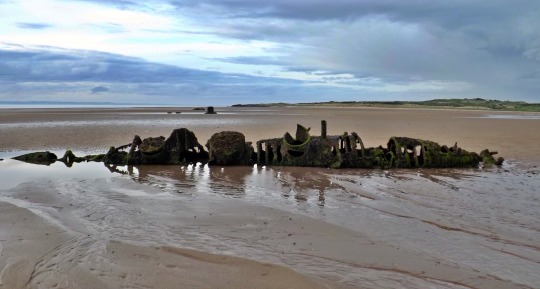
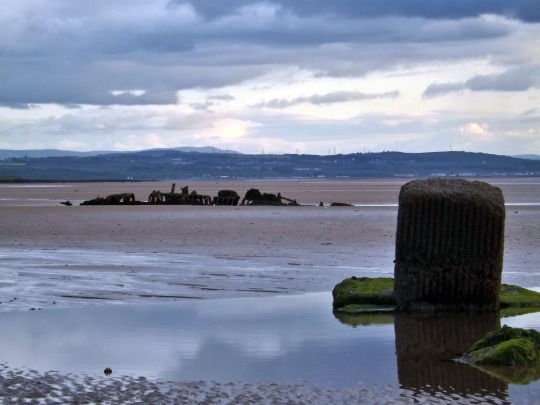

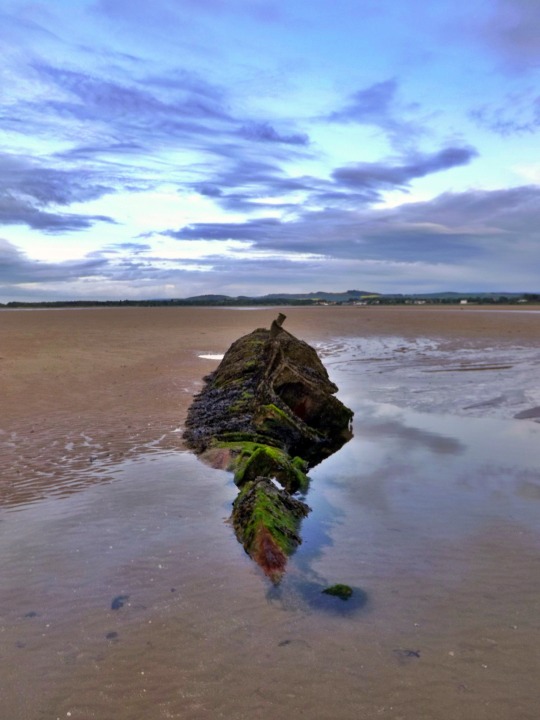



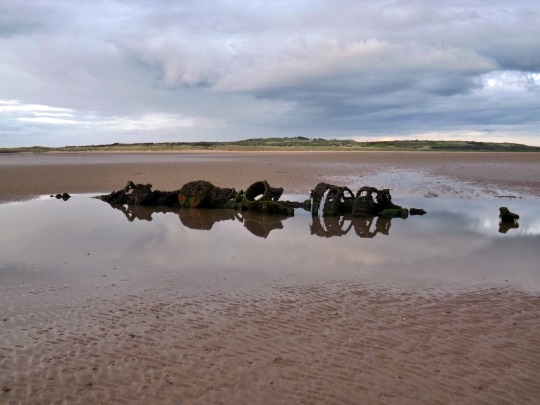

Aberlady Bay’s midget submarines.
I took a trip out to Aberlady last night to catch the low tide where these relics from World War Two are left decaying as the tide comes in and out.
In the spring of 1946, two midget submarines were towed to Aberlady Bay and tethered on either side of an anchor point made of one old concrete anti-tank block set on top of four others. There, over two days of trials in the first week of May, they were fired at by aircraft including Mosquitoes and Seafires (the naval version of the Spitfire) in an experiment to judge the effectiveness of 20 mm cannon shells against the submarines’ steel hulls.
The story of the Aberlady Bay midget submarines was uncovered brilliantly by a researcher named Alison Boutland in a report for the Nautical Archaeology Society. She was able to identify the submarines as XT-craft, a training variant of the X-craft mini submarine.
X-craft were about 16 metres (52 ft) long and powered by a diesel engine when on the surface and an electric motor when underwater. They had a crew of four: a commander, a pilot, an engineer (known as the engine room artificer, or ERA) and a specialist diver. They were used in September 1943 in a daring raid on the German battleship Tirpitz in a fjord in the far north of Norway – a mission that inspired the 1955 film ‘Above us the Waves’, starring John Mills.
The XT submarines, built by Vickers Armstrong at Barrow-in-Furness, were used not just for training X-craft crews, but also to stand in for full-size submarines in training exercises in which they were hunted from air and sea. The XT-craft were simpler than X-craft, since they did not need as much equipment. In particular, they did not have a retractable periscope; the periscope was fixed in a fin-like housing on the top of the submarine. The distinctive eye-shaped attachment point for this periscope housing was clearly identified by Boutland on the two Aberlady Bay wrecks.
Six XT-craft were built, named Extant, Sandra, Helen, Excelsior, Extended and Xantho. When the war in Europe drew to a close, they were no longer needed, and in June 1945 all six were sent to the Naval Construction and Research Establishment in Rosyth. Boutland was not able to figure out which of the six were used for the target trials, although she did conclude that the better-preserved wreck is probably not XT-5, Extended, which, as its name suggests, was modified to be a little longer than the others.
The cannon-fire trials took place on May 1, 1946 and, after the subs were patched up and re-floated, May 6, 1946. The website East Lothian at War, which has the dates as May 2 and May 7, says that the first trial involved armour-piercing shells and the second high-explosive shells, and that the latter proved more effective. Surviving documentation includes annotated photos of the subs showing the damage after the attacks.
Aberlady Conservation and History Society was recently given movie footage of the trials, filmed by a naval officer from the deck of a boat from which the operation was observed, and in 2019 the footage was digitised and posted on YouTube, the footage, although in colour, is not great, I will post it below for you to have a wee look at.
An interesting addition to the story of the submarines comes from Coastkid, a local blogger and Surly fat bike enthusiast, who has evidence that the subs continued to be used as targets for live firing practice by aircraft based at Drem. He recalls working as a greenkeeper at Gullane in the 1980s and finding dozens of spent 0.5 inch shell cartridges as well as 20 mm cartridges, and he was told by a retired tractor driver that aircraft used to line themselves up using a marker pole behind the seventh tee on Gullane No 3 course, and fire when over the rows of anti-tank blocks, near the green of the twelfth hole on No 2 course.
youtube
27 notes
·
View notes
Text
A More Perfect Servant
A bolt of light streaks through the air, faster than the human eye can track, aimed unerringly for my servant's heart. A blur of motion intercepts it, and with a sharp crack of sound, the magically charged arrow is deflected to the side.
Good puppet. Well done.
Unseen by these irksome intruders, my claws stroke the back of Emilia's head, tipping her annoyance with a gentle nudge toward contempt. Still, she almost wavers when she recognizes her enemies. I grip her more tightly to steady her thoughts.
Three of them. I dismiss the first, a knight built like a giant slab of meat gripping a giant slab of steel as a shield. An unremarkable simpleton. Even now, my servant wants to think of him as a friend, however. I squash the thought before she can be allowed to think it.
More dangerous is the young, newly crowned king leveling that divine blade at us. Even without that telltale glow, I'd recognize the stench of the goddess on it. The thing is littered with countless more enchantments, too.
How many sorcerers and master craftsmen were involved in constructing this weapon? Did he empty the royal coffers to commission that sword just to kill us? Oh, he must be quite furious about my puppet killing his parents.
But my servant, predictably, cannot wrest her attention away from the third—the doe-eyed priestess with the goddess's gifts—and I haven't decided whether it's her powers or this girl's obsession with her that makes her the greatest threat of all.
The priestess nocks another arrow, and she channels the power that is her birthright into it. However, instead of taking aim, she makes one more attempt to break my hold on her friend.
"If you're still in there, you have to fight that demon's control. Don't make us kill you!"
I whisper poison into an ear that cannot shut me out, and my servant's lips move to speak the jealousy I plant inside her.
"Don't pretend that you suddenly care about me now. You made your choice, didn't you?" I paint a sneer on her mouth.
"The Anchor needs—"
"Your goddess demands an heir to inherit her gift," my puppet interrupts, that word dripping with resentment that isn't even mine, "something I could never give you. But he can, can't he? Merging the royal bloodline with your holy one. How perfect."
The large one responds to all the malice in her words, moving to place his shield between the threat she represents and his friends.
My puppet is insulted. I stoke her fury until a violent outburst carries her forward, leaping over his shield to bury her glaive in his skull.
That's one down. Now…
Wait. What—?
I tug the strings, but my puppet only stiffens. She drops her weapon. Tears fill her eyes.
"Kill me. Please," she begs.
Disgusting words that I did not feed her. I squash her pity. I smother her revulsion. Still she resists me.
We have so much more to do. We're burning this entire world down. What is the point of such a display for this tiny, insignificant group of people?
"Hurry, I can't—"
The next holy arrow strikes true. Right in the heart. My servant falls.
Intolerable failure.
"I-is it over?"
No resurrecting my servant. The arrow's power repels me.
"That demon of hers will try again. Maybe with one of us."
The priestess would have to intentionally lower her natural defenses for me to take her, and the sword in the king's hands works similarly.
The dead knight, maybe. Wouldn't be my first choice, but my options are limited. Humans are sentimental creatures. Perhaps they'll drag his corpse back, with me in tow, and I'll have more choices open to me later.
I slip into the body.
Careless, too used to inhabiting an empowered servant, I don't notice the trap until it's too late. Wards on the body flare with heat and light, and the king's reflexes are swift. He plunges that holy blade through his dead friend's chest and into me.
"Got you," he growls.
Sealed away by the sword's power, howling in futility at the goddess's repulsive servants, I am unable to lift a finger to resist as they add layer upon layer of imprisonment. Wrapped, chained, locked away in a remote temple, they think me gone forever.
But it is my nature to corrupt, and while the blade has no will of its own to seduce, it likewise has no will to resist as I wear away at its essential nature with time.
A century, a millennium, a myriad years—however long it takes, I will make this sword-prison mine.
Slowly, oh-so-slowly, I twist the blade's light into alignment with my power and my nature. As I do so, I study it and come to know the power of the holy bloodline far more intimately than ever before.
The priestess herself once imbued this sword with her power. The bond remains, and I can trace it back, back, back to her descendants.
Somewhere out there a princess dreams, and I seed her fertile mind with prophetic nightmares of what I'll do to her kingdom. There is no scheme in it. No grand plan. It's an act of spite at enmity's heir. What happens next is simply good fortune.
She half-recalls a distorted legend of a sword that seals away darkness. She sends a champion to claim a weapon to fight my prophecy.
And then one day I feel the caress of a strong hand once again.
The blade I embody is wholly under my command, and the power this new knight claims is equally mine.
I sink my fangs into her mind, expecting to struggle with her for dominance the way I did with Emilia.
Instead she exhales a sigh of pleasure. She strokes me like a lover.
Her mind's eye shows me crimson-stained visions of her enemies, and all I have to whisper is "yes."
30 notes
·
View notes
Text
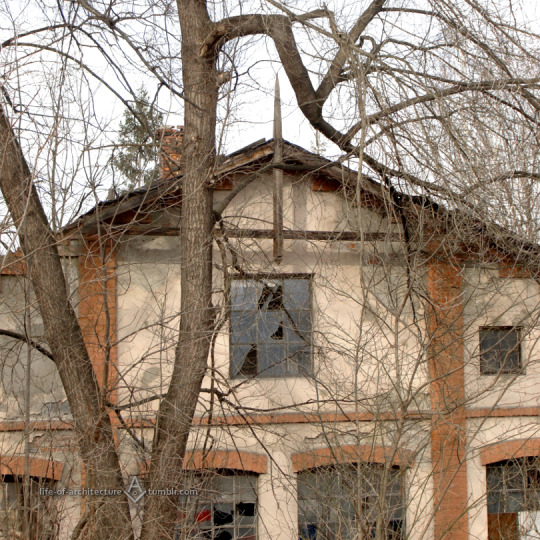

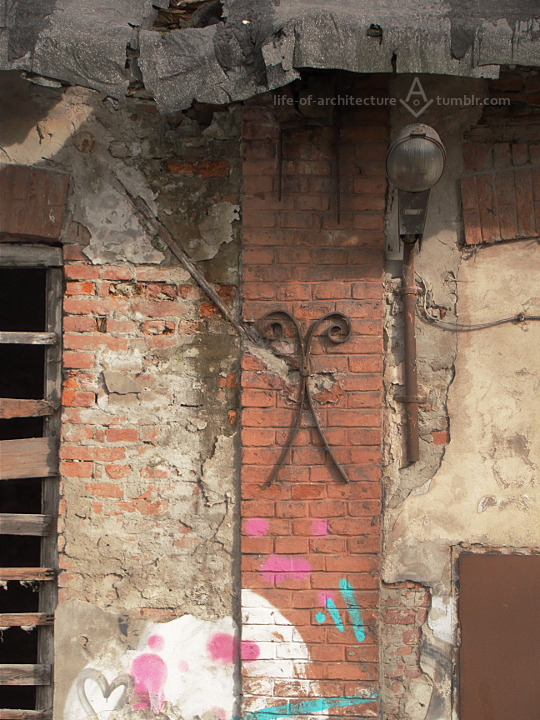
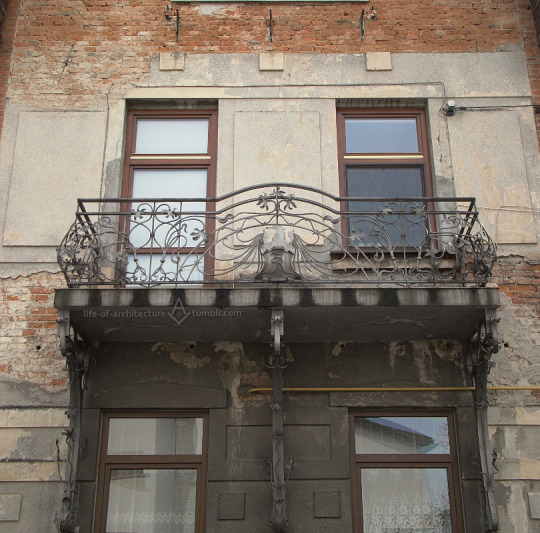

Nowy Sącz ul. Fabryczna foto z 16 lutego 2020
Na trzech pierwszych zdjęciach południowy szczyt, resztki dachu i ankier na ścianie hali fabrycznej z 1906 r. Należała do Józefa Rossmanitha, który otworzył tu swoje przedsiębiorstwo najpierw pod nazwą Odlewarni Żelaza, Stali i Metalów, a rozszerzywszy działalność, z czasem przemianował na Fabrykę Maszyn, Wyrobów i Konstrukcyi Żelaznych. Maszyny fabryczne napędzał nurt Młynówki, nieistniejącego dziś sztucznego strumienia zasilanego wodą pobliskiej rzeki Kamienicy. Koło wodne fabryki miało moc 42 koni mechanicznych. Na dwóch ostatnich zdjęciach frontowa elewacja stojącego obok fabryki domu Rossmanithów z lat 1912-1914 r. projektu Zenona Adama Remiego, z kutą balustradą balkonową, prezentującą możliwości firmy.
Małżeństwo Rossmanithów. Urodzony w czeskiej Opawie, w spolonizowanej rodzinie niemieckiej, Józef poślubił Etelkę Adelajdę von Bartfai z węgierskiej rodziny Grünwaldów, z Bardejowa. Stąd w domu z kutym balkonem mówiono wtedy głównie po węgiersku.

Załoga fabryki w drugiej dekadzie XX w. Pośrodku widoczna prawdopodobnie Maria Maak, główna księgowa, a po śmierci Józefa Rossmanitha w 1914 r. kierowniczka firmy. W latach świetności, w fabryce pracowało 60 robotników. W 1920 r. zastrajkowali, czym wywalczyli sobie ośmiogodzinny dzień pracy.

Ogłoszenia reklamowe firmy z 1906…
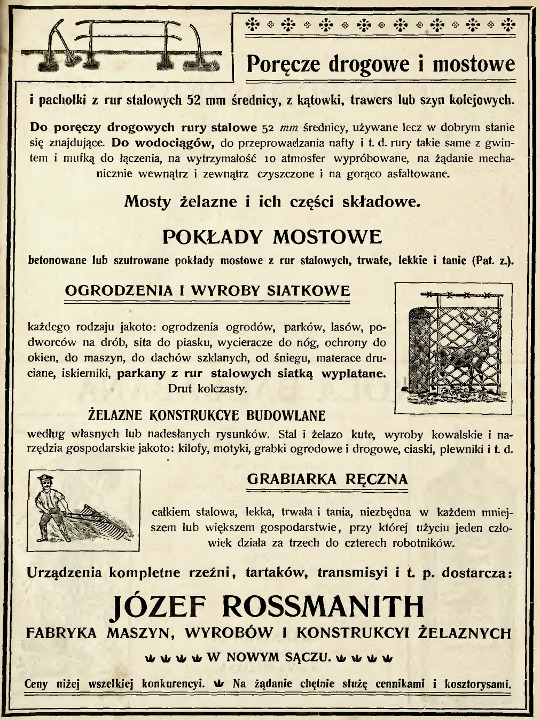
…i 1912 r.

><><><><><><><><><><><><><><><
Nowy Sącz, Poland Fabryczna Street taken on 16 February 2020
First three photos show the southern facade, remains of the roof and an anchor plate on the wall of a factory hall built in 1906 r. It was a property of Józef Rossmanith who started his business here first as Iron, Steel and Metals Foundry and after diversifying the production renamed it Factory of Machines, Iron Products and Constructions. The factory equipment was powered by a waterwheel generating 42 hp thanks to nonexistent today Młynówka, an artificial stream supplied by the nearby Kamienica river. Two latter photos show the front facade of the nearby Rossmaniths house from 1912-1914, designed by Zenon Adam Remi. The wrought iron balcony used to present the factory's abilities.
[the married Rossmanith couple] Józef, born in Opava in a family of polonised Germans, married Etelka Adelajda von Bartfai née Grünwald, a Hungarian from Bardejov. Hence the default language of their household behind the iron balcony was Hungarian.
[the factory crew in 1910s] In the center is most likely Maria Maak, the main accountant and after Józef Rossmanith's death in 1914 also the main manager. In the prime years up to 60 people used to work there. In 1920 they went on a strike that ended succesfully with an agreement for the 8h workday.
[the Rossmanith factory's ads from 1906] [and 1912]
#historical facts#factories#industrial architecture#labour history#vintage ads#photographers on tumblr#original photography#Central Europe#Eastern Europe#Poland#Polska#Nowy Sącz#Nowy Sacz#balconies#wrought iron#eagles in art#retro#local history#family business#early capitalism
11 notes
·
View notes
Note
Let's transform a 0 point 0 1 square meter space into a functional house. Mannequin Mark lived frugally and worked diligently in a woodworking business for two years managing to save up half a million to buy a house in New York.
However, upon moving in, he was shocked by how small it was, tripping upon walking in but was saved by his childhood eagle. He couldn't even fit his grandma's coffin.
Poor Mark had to tie himself up to the doorframe to get a proper night's rest. He would lay on his eagle's and cry. Eventually, he got sick of it and decided for renovation.
Now, let's explore how we can help Mannequin Mark transform it into a functional home.
First, we'll construct a durable frame using galvanized square steel anchored firmly to the wall with expansion screws borrowed from his aunt filled with grid steel bars and concrete for lasting strength.
We'll also install thermally broken aluminum windows, expanding the living space by 2 square meters.
Next, we'll build a multifunctional sitting platform on the floor with hidden storage underneath for bulky items, saving precious space and providing a seating area for Mark and his husband, Wallter. This platform doubles as a comfortable bed that can fit two people, surrounded by cushion panels in blue and yellow for a better rest.
We'll add a movable table on the bed to serve as both a workspace and dining area, with an outlet switch nearby for charging devices, making it perfect for work and meals.
After use, the table can be stored beside the bed, keeping the space organized. Add a projector and projector screen so he can watch his Korean Dramas.
We'll then construct a bedframe from galvanized square steel, enhancing its appearance with eco-friendly wood veneers.
Incorporate a pre-buried drainage system for convenience. Build a set of wall cabinets with a countertop drilled to embed a sink. Underneath, install a build in washing-machine to keep dirty laundry at bay.
Convert the countertop for dual use by placing an induction cooker for cooking, and install a mirror cabinet above. Next to the mirror, add a cabinet for spices and toiletries. Install a showerhead on the wall and an enlarged stand, allowing even space to ride a horse while showering.
Now his tiny space has everything he needs
"Did tou just send me an entire fucking home decor story or whatever. For MANNEQUIN_MARK.?"
6 notes
·
View notes